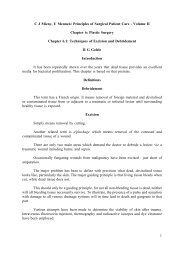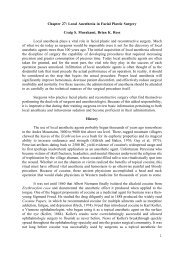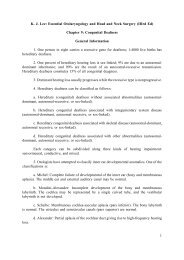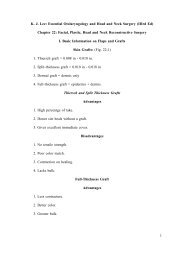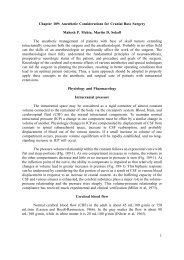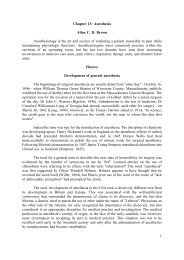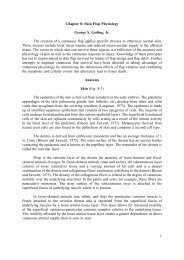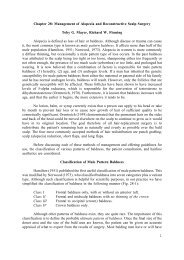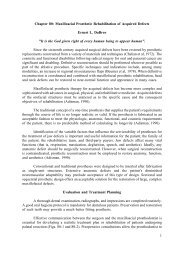1 Chapter 99: Congenital Disorders of the Larynx ... - Famona Site
1 Chapter 99: Congenital Disorders of the Larynx ... - Famona Site
1 Chapter 99: Congenital Disorders of the Larynx ... - Famona Site
You also want an ePaper? Increase the reach of your titles
YUMPU automatically turns print PDFs into web optimized ePapers that Google loves.
tracheotomy because <strong>of</strong> <strong>the</strong> relatively high chance <strong>of</strong> hypoxic cerebral damage or death. The<br />
tracheotomy can usually be removed between 6 to 18 months <strong>of</strong> age.<br />
The patients can be divided into three distinct groups according to <strong>the</strong> airway<br />
management found to be necessary for <strong>the</strong> severity <strong>of</strong> airway obstruction and <strong>the</strong> eventual<br />
outcome.<br />
Mild<br />
Moderate<br />
Severe<br />
Posture alone<br />
Nasopharyngeal tube<br />
Short-term intubation, tracheotomy, or death.<br />
Experience shows that no one method <strong>of</strong> airway management is effective for every<br />
patient. Nasotracheal intubation in many cases can secure a certain, safe airway that can be<br />
maintained for many weeks with painstaking nursing care if necessary over a prolonged<br />
period. The airway obstruction inevitably improves with time as <strong>the</strong> anatomic structures<br />
assume a more normal anatomic relationship and <strong>the</strong> tone in <strong>the</strong> tongue and pharyngeal<br />
musculature improves.<br />
The death rate can be from 10% to 20%. The deaths from respiratory obstruction<br />
indicate <strong>the</strong> prime importance <strong>of</strong> airway management and <strong>the</strong> need for tracheotomy in severe<br />
cases.<br />
Abnormalities <strong>of</strong> midfacial skeleton<br />
Infants with Treacher Collins' syndrome (mandibul<strong>of</strong>acial dysostosis), Apert's<br />
syndrome (acrocephalosyndactyly), Crouzon's syndrome (crani<strong>of</strong>acial dysostosis), and o<strong>the</strong>r<br />
diseases may have nasal airway obstruction, retrognathia, and malocclusion, so that posterior<br />
displacement <strong>of</strong> <strong>the</strong> midfacial structures causes oropharyngeal upper airway obstruction. In<br />
older children with <strong>the</strong>se anomalies sometimes adenoid hypertrophy exists, making <strong>the</strong> chronic<br />
nasopharyngeal obstruction worse and causing episodes <strong>of</strong> obstructive sleep apnea. In <strong>the</strong>se<br />
patients removal <strong>of</strong> <strong>the</strong> adenoids and tonsils may be dramatically effective.<br />
In <strong>the</strong> neonatal period, however, conservative management <strong>of</strong> <strong>the</strong> airway obstruction<br />
by vigilant nursing maintenance <strong>of</strong> a suitable posture and supportive measures is usually<br />
sufficient. In severe or refractory cases, a tracheotomy is indicated.<br />
Oropharyngeal obstruction<br />
A cause <strong>of</strong> oropharyngeal obstruction is macroglossia, which may be primary<br />
(cretinism, Beckwith-Wiedemann syndrome), secondary (lymphangioma, hemangioma), part<br />
<strong>of</strong> ano<strong>the</strong>r congenital syndrome, or idiopathic. Reduction <strong>of</strong> tongue size by surgical excision<br />
<strong>of</strong>fers an acceptable functional result with minimal morbidity (Rizer et al, 1985).<br />
Aberrant thyroid tissue is most commonly seen as lingual thyroid at <strong>the</strong> foramen<br />
cecum in <strong>the</strong> base <strong>of</strong> <strong>the</strong> tongue but has been reported elsewhere in <strong>the</strong> pharynx as a cause<br />
<strong>of</strong> airway obstruction. Great care must be taken before a lingual thyroid is considered for<br />
removal, since it may be <strong>the</strong> only functioning thyroid tissue in <strong>the</strong> body. A radioactive thyroid<br />
scan detects any o<strong>the</strong>r functioning thyroid tissue that is present.<br />
15




